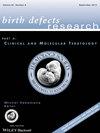Emily L. Durham, R. Nicole Howie, Laurel Black, Grace Bennfors, Trish E. Parsons, Mohammed Elsalanty, Jack C. Yu, Seth M. Weinberg, James J. Cray Jr.
下载PDF
{"title":"甲状腺素暴露对Twist 1 +/−表型的影响:颅缝闭锁的基因-环境相互作用模型测试","authors":"Emily L. Durham, R. Nicole Howie, Laurel Black, Grace Bennfors, Trish E. Parsons, Mohammed Elsalanty, Jack C. Yu, Seth M. Weinberg, James J. Cray Jr.","doi":"10.1002/bdra.23543","DOIUrl":null,"url":null,"abstract":"<div>\n \n <section>\n \n <h3> Background</h3>\n \n <p>Craniosynostosis, the premature fusion of one or more of the cranial sutures, is estimated to occur in 1:1800 to 2500 births. Genetic murine models of craniosynostosis exist, but often imperfectly model human patients. Case, cohort, and surveillance studies have identified excess thyroid hormone as an agent that can either cause or exacerbate human cases of craniosynostosis.</p>\n </section>\n \n <section>\n \n <h3> Methods</h3>\n \n <p>Here we investigate the influence of <i>in utero</i> and <i>in vitro</i> exogenous thyroid hormone exposure on a murine model of craniosynostosis, <i>Twist 1 +/−</i>.</p>\n </section>\n \n <section>\n \n <h3> Results</h3>\n \n <p>By 15 days post-natal, there was evidence of coronal suture fusion in the <i>Twist 1</i> +/− model, regardless of exposure. With the exception of craniofacial width, there were no significant effects of exposure; however, the <i>Twist 1 +/−</i> phenotype was significantly different from the wild-type control. <i>Twist 1 +/−</i> cranial suture cells did not respond to thyroxine treatment as measured by proliferation, osteogenic differentiation, and gene expression of osteogenic markers. However, treatment of these cells did result in modulation of thyroid associated gene expression.</p>\n </section>\n \n <section>\n \n <h3> Conclusion</h3>\n \n <p>Our findings suggest the phenotypic effects of the genetic mutation largely outweighed the effects of thyroxine exposure in the <i>Twist 1</i> +/− model. These results highlight difficultly in experimentally modeling gene–environment interactions for craniosynostotic phenotypes. Birth Defects Research (Part A) 106:803–813, 2016. © 2016 Wiley Periodicals, Inc.</p>\n </section>\n </div>","PeriodicalId":8983,"journal":{"name":"Birth defects research. Part A, Clinical and molecular teratology","volume":"106 10","pages":"803-813"},"PeriodicalIF":0.0000,"publicationDate":"2016-07-20","publicationTypes":"Journal Article","fieldsOfStudy":null,"isOpenAccess":false,"openAccessPdf":"https://sci-hub-pdf.com/10.1002/bdra.23543","citationCount":"7","resultStr":"{\"title\":\"Effects of thyroxine exposure on the Twist 1 +/− phenotype: A test of gene–environment interaction modeling for craniosynostosis\",\"authors\":\"Emily L. Durham, R. Nicole Howie, Laurel Black, Grace Bennfors, Trish E. Parsons, Mohammed Elsalanty, Jack C. Yu, Seth M. Weinberg, James J. Cray Jr.\",\"doi\":\"10.1002/bdra.23543\",\"DOIUrl\":null,\"url\":null,\"abstract\":\"<div>\\n \\n <section>\\n \\n <h3> Background</h3>\\n \\n <p>Craniosynostosis, the premature fusion of one or more of the cranial sutures, is estimated to occur in 1:1800 to 2500 births. Genetic murine models of craniosynostosis exist, but often imperfectly model human patients. Case, cohort, and surveillance studies have identified excess thyroid hormone as an agent that can either cause or exacerbate human cases of craniosynostosis.</p>\\n </section>\\n \\n <section>\\n \\n <h3> Methods</h3>\\n \\n <p>Here we investigate the influence of <i>in utero</i> and <i>in vitro</i> exogenous thyroid hormone exposure on a murine model of craniosynostosis, <i>Twist 1 +/−</i>.</p>\\n </section>\\n \\n <section>\\n \\n <h3> Results</h3>\\n \\n <p>By 15 days post-natal, there was evidence of coronal suture fusion in the <i>Twist 1</i> +/− model, regardless of exposure. With the exception of craniofacial width, there were no significant effects of exposure; however, the <i>Twist 1 +/−</i> phenotype was significantly different from the wild-type control. <i>Twist 1 +/−</i> cranial suture cells did not respond to thyroxine treatment as measured by proliferation, osteogenic differentiation, and gene expression of osteogenic markers. However, treatment of these cells did result in modulation of thyroid associated gene expression.</p>\\n </section>\\n \\n <section>\\n \\n <h3> Conclusion</h3>\\n \\n <p>Our findings suggest the phenotypic effects of the genetic mutation largely outweighed the effects of thyroxine exposure in the <i>Twist 1</i> +/− model. These results highlight difficultly in experimentally modeling gene–environment interactions for craniosynostotic phenotypes. Birth Defects Research (Part A) 106:803–813, 2016. © 2016 Wiley Periodicals, Inc.</p>\\n </section>\\n </div>\",\"PeriodicalId\":8983,\"journal\":{\"name\":\"Birth defects research. Part A, Clinical and molecular teratology\",\"volume\":\"106 10\",\"pages\":\"803-813\"},\"PeriodicalIF\":0.0000,\"publicationDate\":\"2016-07-20\",\"publicationTypes\":\"Journal Article\",\"fieldsOfStudy\":null,\"isOpenAccess\":false,\"openAccessPdf\":\"https://sci-hub-pdf.com/10.1002/bdra.23543\",\"citationCount\":\"7\",\"resultStr\":null,\"platform\":\"Semanticscholar\",\"paperid\":null,\"PeriodicalName\":\"Birth defects research. Part A, Clinical and molecular teratology\",\"FirstCategoryId\":\"1085\",\"ListUrlMain\":\"https://onlinelibrary.wiley.com/doi/10.1002/bdra.23543\",\"RegionNum\":0,\"RegionCategory\":null,\"ArticlePicture\":[],\"TitleCN\":null,\"AbstractTextCN\":null,\"PMCID\":null,\"EPubDate\":\"\",\"PubModel\":\"\",\"JCR\":\"Q\",\"JCRName\":\"Medicine\",\"Score\":null,\"Total\":0}","platform":"Semanticscholar","paperid":null,"PeriodicalName":"Birth defects research. Part A, Clinical and molecular teratology","FirstCategoryId":"1085","ListUrlMain":"https://onlinelibrary.wiley.com/doi/10.1002/bdra.23543","RegionNum":0,"RegionCategory":null,"ArticlePicture":[],"TitleCN":null,"AbstractTextCN":null,"PMCID":null,"EPubDate":"","PubModel":"","JCR":"Q","JCRName":"Medicine","Score":null,"Total":0}
引用次数: 7
引用
批量引用




 求助内容:
求助内容: 应助结果提醒方式:
应助结果提醒方式:


